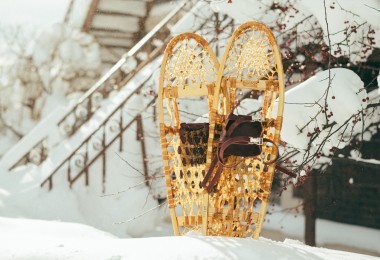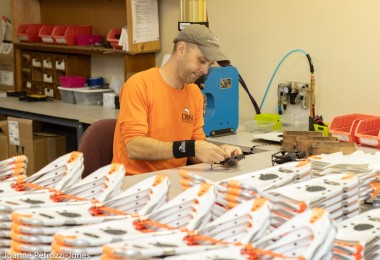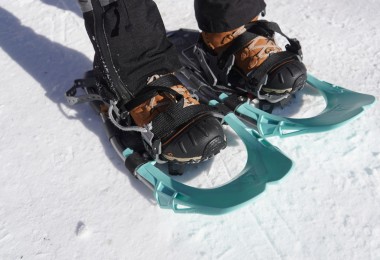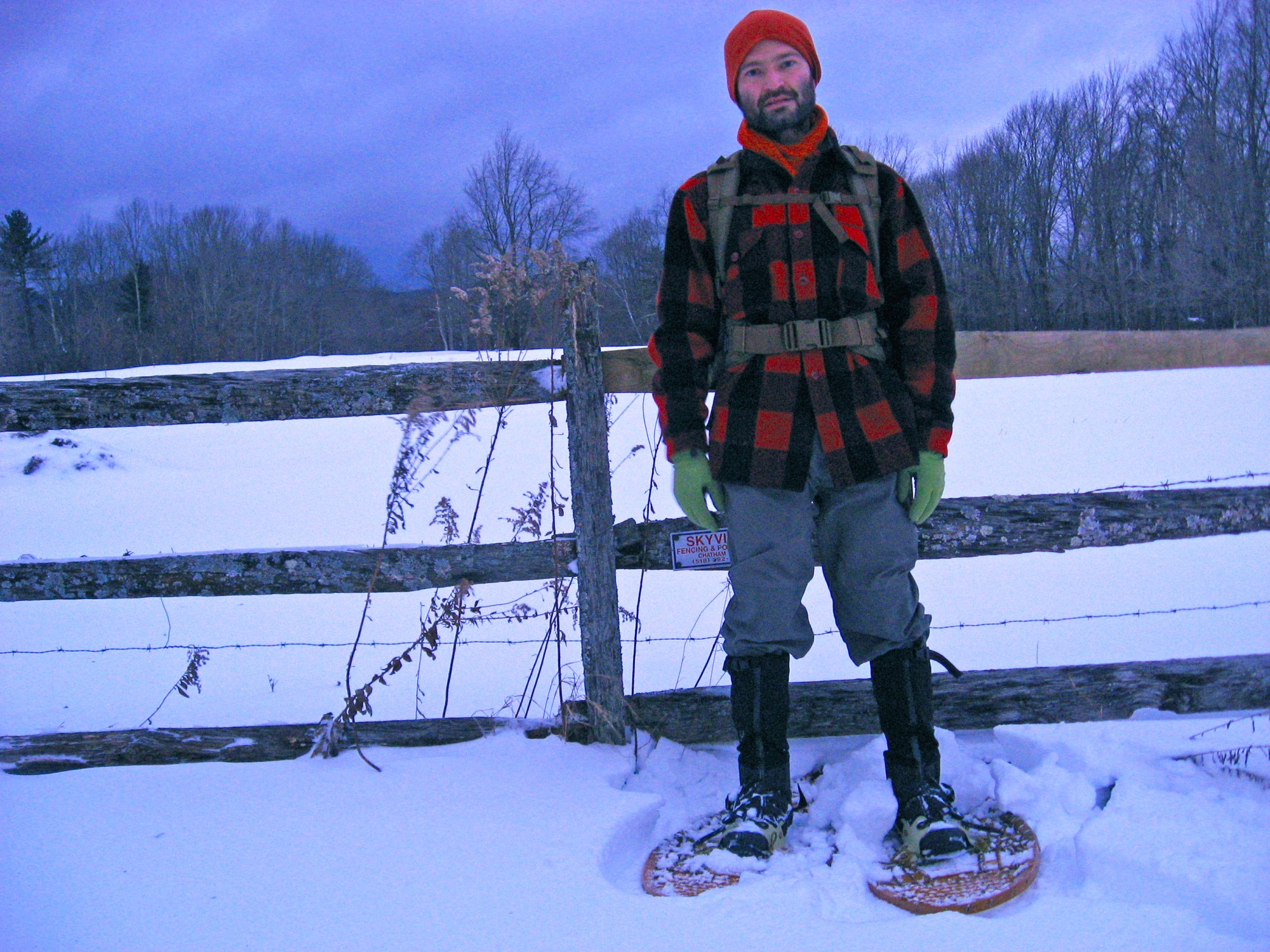I’ve had the same pair of snowshoes since I was 16, and I’m now 34. Over those years, my wooden framed Huron-style snowshoes have traversed many a trail over the years. Eighteen years is a long time for anything to last, especially in a day and age of disposable and dispensable items. However, with some common sense and care mixed in with a bit of annual maintenance, traditional snowshoes constructed of wood and rawhide will last a lifetime.
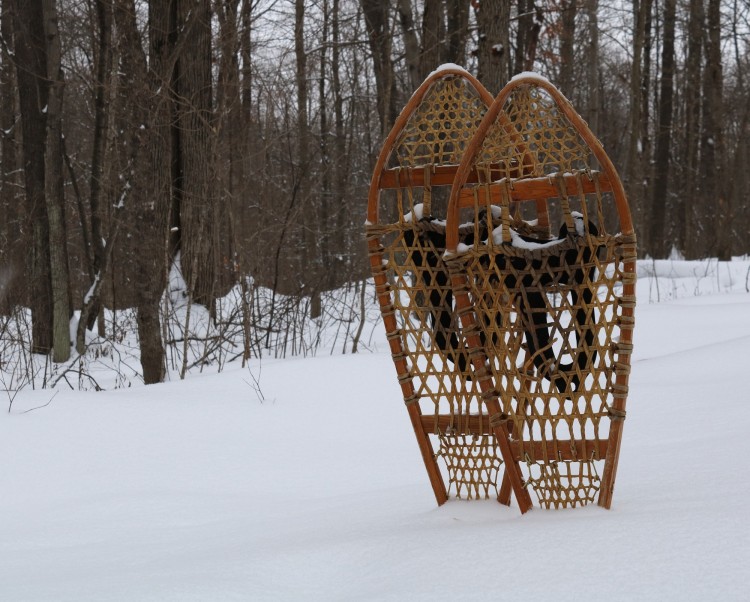
By taking care of your wooden snowshoes, you can ensure they last for years. Photo: Shutterstock / Aaron J Hill
Some of the links in this article may contain affiliate links. When you purchase using these links, part of the proceeds go to Snowshoe Mag. Additionally, as Amazon Associates, we earn from qualifying purchases. Please see our disclosure for more details.
End of Season Traditional Snowshoe Maintenance
Once the snowshoeing season is over, a couple of basic maintenance tasks will ensure that your snowshoes will have a long and productive life.
Varnish
At the end of the season, a yearly coat of clear varnish to both the wooden frame and rawhide webbing will help preserve your traditional snowshoes.
Without varnish, the webbing can become loose, which causes you to lose floatation in deep snow. Or, unvarnished webbing can deteriorate to the point that it will need replacing. Furthermore, exposed and unvarnished wood will absorb moisture and weaken the snowshoe frame, thus reducing the lifespan of your snowshoes.
Remember that even if your snowshoes have neoprene lacing, it is still necessary to varnish the wooden frame.
Read More: Traditional Snowshoe Bindings 101
Recommended Materials
In addition to medium-grit sandpaper, you’ll also need to choose a varnish. My varnish of choice is marine spar varnish, a combination of tung oil, phenolic resin, and UV inhibitors.
Marine spar varnish provides a high gloss finish that flexes with the wood to help prevent cracking and is readily available at most hardware stores as either a liquid or a spray. As the name implies, marine spar varnish is used on boats to protect the wood from water and salt. Thus, it’s ideal for snowshoes. It also contains UV inhibitors to help protect against damage from the sun.
Alternatively, you can use a varathane finish. Make sure the finish has UV inhibitors when choosing one for your snowshoes.
Steps To Apply Varnish
- Before applying a coat of varnish, take a piece of medium-grit sandpaper.
- Use the sandpaper to remove loose bits of old varnish that have peeled or flaked away from the frame, leaving the wood or webbing beneath exposed. Take care not to sand excessively. You’re only trying to remove loose flakes of old varnish, not weaken the frame or rawhide by sanding off the wood or webbing.
- Then, apply the varnish to the frame and webbing. When applying a coat of varnish, don’t be afraid to be generous. Be exceptionally generous on the heel’s rawhide and along the mastercord, located near the center beneath where you attach the bindings. These areas tend to suffer the most wear.
- Ideally, if time permits, let the freshly varnished snowshoes dry for 48 hours.
- Finally, apply a second coat, repeating steps 3 and 4.
Read More: How To Care for Wood-Frame Snowshoes
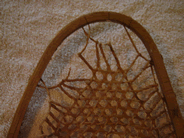
The rawhide decking has deteriorated and snapped. Plus, the varnish has worn away, leaving the frame exposed due to a lack of care. Photo: Craig Gillespie
Traditional Snowshoe Storage
Storing your snowshoes probably isn’t that high on the concerns related to caring for your snowshoes. However, storage is critical if you’re lucky enough to have a handcrafted pair of traditional snowshoes, such as wooden snowshoes with rawhide or babiche lacing. It should be near the top of your list of traditional snowshoe care once the season is over.
Where To Store Your Snowshoes
You must store your snowshoes in a cool, dry location with adequate ventilation.
Heat and damp areas are not the best combinations for preserving the wooden frame or the rawhide webbing of your traditional snowshoes. So, tossing your shoes into a corner in your dank, musty basement or garage is not necessarily the ideal storage solution.
Moreover, heat and dampness can cause mildew and mold to grow on the webbing. Or even worse than that, the wooden frames can warp.
How To Store Your Snowshoes
Wherever you store your traditional snowshoes, ensure they are kept off the ground, preferably in a difficult location for rodents to reach. Much like your pal Rover, rawhide is a tasty treat to mice and other rodents.
But, believe me, even a single mouse can wreak havoc on rawhide webbing. So I’ve found that hanging my snowshoes using a couple of coat pegs in the back closet works well.
Prep Before Storing
This step may sound contradictory to everything said about wooden snowshoes and moisture. However, at the end of the season and before varnishing, it isn’t a bad idea to give your traditional snowshoes a gentle wash, primarily if you’ve used them in a region near saltwater.
Salt will cause the rawhide to deteriorate. After washing, let your snowshoes air dry in an area that isn’t too hot. Typically, room temperatures of 17 to 20 degrees C (62 to 68 degrees F) work well, as extreme heat can cause the frames to warp.
Read More: Hang It Up for the Season: Snowshoe Care and Storage
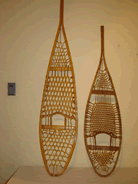
The snowshoe on the left has received a regular coat of varnish and proper storage. Notice the bright color of the frames and intact decking. In contrast, the snowshoe on the right, however, has not. Improper care caused the rawhide to snap and the frame to warp. Photo: Craig Gillespie
In-Season Traditional Snowshoe Care
There are also several practical tasks that you should perform during snowshoe season to ensure that your snowshoes remain in good shape.
Regularly Check For Damage
The first task is to check your traditional snowshoes for damage after each time you use them. Look for abrasions and cracks in the varnish and frames.
Varnish During The Season (If Needed)
If the varnish has been scraped or peeled off the rawhide webbing, your snowshoes will require varnishing. However, before applying a coat of varnish, it’s essential first to dry out your snowshoes. Like when storing, take care not to expose your snowshoes to high temperatures when drying.
When varnishing in-season, applying a second coat over the damaged area would be a good idea if time permits.
Reinforce Any Cracks
If the frames have suffered a minor crack, you can reinforce the frame by wrapping the damaged area with cloth tape. Or, if necessary, the break can be splinted with a thin strip of aluminum and then covered with some cloth tape.
It is best to contact the snowshoes’ manufacturer for heavily damaged snowshoes.
Read More: Create Your Homemade Snowshoe Repair Kit
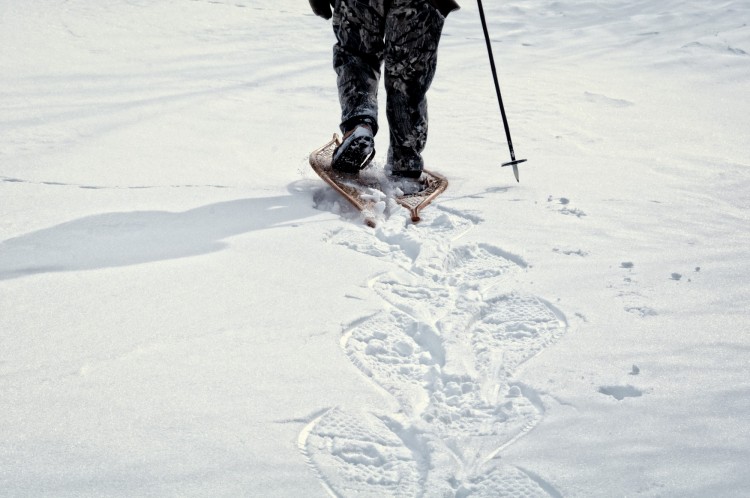
After each snowshoe outing, it’s essential to check your wooden snowshoes for damage to the frame and webbing. Photo: Shutterstock / angelshot
Take Care of Your Traditional Snowshoes
Following these basic maintenance and storage techniques will undoubtedly aid your snowshoes in achieving a long and useful career out on the trail.
How do you take care of your wooden snowshoes? Do you have any other recommendations? Let us know in the comments below!
This article was originally published on November 15, 2004, and most recently updated on August 25, 2022.
Read Next: Making Your Snowshoes From Scratch

